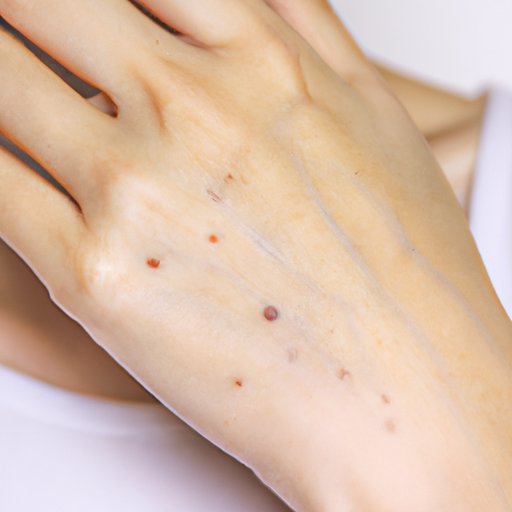Introduction
Peeling skin on your hands can be concerning and uncomfortable. While it’s typically not serious, it can be a sign of an underlying condition. It’s important to understand the causes, symptoms, and treatment options so you can take steps to reduce discomfort and improve the appearance of your hands.

Analyzing the Causes of Peeling Skin on Hands
Peeling skin on your hands can have many causes. Some of the most common include:
Dry Skin
Dry skin is the most common cause of peeling skin on your hands. When your skin is dry, it loses its natural protective layer of oils, which can lead to flaking and peeling. This can happen due to overexposure to cold temperatures, wind, or low humidity levels. It can also occur due to frequent washing or use of harsh soaps.
Allergies
Allergies can also cause your skin to peel. Allergic reactions can cause inflammation, itching, and irritation, which can lead to peeling. Common allergens that may cause this reaction include latex, detergents, fragrances, and certain metals.
Sunburn
Excessive sun exposure can cause sunburn, which can lead to peeling skin. Sunburns can cause redness, swelling, and pain, as well as peeling and blistering of the skin.
Other Causes
Infections, such as ringworm and athlete’s foot, can cause peeling skin. Certain medical conditions, such as psoriasis and eczema, can also cause peeling. Additionally, certain medications, such as topical retinoids, can lead to peeling skin.

Understanding the Symptoms of Peeling Skin on Hands
The most common symptom of peeling skin on your hands is flaking and peeling skin. You may also notice redness, itching, and a burning or stinging sensation. If the peeling is due to an allergic reaction, you may also experience hives or swelling.
Exploring Home Remedies for Peeling Skin on Hands
If your peeling skin is mild, there are some home remedies you can try to help relieve discomfort and improve the appearance of your skin. These include:
Moisturizers
Moisturizing your hands regularly can help keep the skin hydrated and prevent further peeling. Look for a cream or lotion with ingredients such as glycerin, hyaluronic acid, ceramides, and petrolatum.
Cool Compresses
Applying cool compresses to your hands can help soothe inflammation and itching. You can make a compress by soaking a clean washcloth in cold water and wringing it out before applying to your hands.
Oatmeal Baths
Adding oatmeal to a lukewarm bath can help reduce inflammation and moisturize your skin. Use plain oatmeal or colloidal oatmeal, which is finely ground oatmeal. Soak in the bath for 10-15 minutes before patting your skin dry.
Aloe Vera
Aloe vera has anti-inflammatory and moisturizing properties that can help soothe and heal irritated skin. You can purchase aloe vera gel from your local drugstore or use the gel from an aloe vera plant. Apply the gel directly to your hands and leave it on for 15-20 minutes.

Investigating Medical Treatments for Peeling Skin on Hands
If your peeling skin does not improve with home remedies, you may need to see a doctor. Your doctor may prescribe one or more of the following treatments:
Prescription Creams
Your doctor may prescribe topical creams, such as corticosteroids, to reduce inflammation and itching. These creams can also help reduce the appearance of peeling skin.
Steroid Injections
If your peeling skin is severe and does not respond to topical treatments, your doctor may recommend steroid injections. Steroid injections can help reduce inflammation and improve the appearance of your skin.
Phototherapy
Phototherapy involves exposing your skin to ultraviolet light. This treatment can help reduce inflammation, itching, and peeling. Phototherapy is usually done in a doctor’s office and is not recommended for people with light skin.
Examining Prevention Strategies for Peeling Skin on Hands
You can take steps to prevent peeling skin on your hands. These include:
Wear Gloves When Cleaning
When cleaning, wear gloves to protect your hands from harsh chemicals and irritants. This can help prevent dryness and irritation, which can lead to peeling skin.
Use Sunscreen
Wear sunscreen on your hands when spending time outdoors to protect them from sun damage. Look for a sunscreen with an SPF of 30 or higher and apply it every two hours.
Avoid Harsh Soaps
Avoid using harsh soaps and cleansers on your hands. Instead, opt for mild, fragrance-free soaps and moisturizing hand washes.
Stay Hydrated
Drinking plenty of fluids helps keep your skin hydrated and prevents dryness and irritation. Aim for eight glasses of water per day.
Conclusion
Peeling skin on your hands can have many causes, including dry skin, allergies, sunburn, infections, and medical conditions. Common symptoms include flaking and peeling skin, redness, itching, and a burning or stinging sensation. Home remedies, such as moisturizers, cool compresses, oatmeal baths, and aloe vera, can help reduce discomfort and improve the appearance of your skin. If these treatments do not work, your doctor may recommend prescription creams, steroid injections, or phototherapy. To prevent peeling skin, wear gloves when cleaning, use sunscreen, avoid harsh soaps, and stay hydrated. With the right treatment plan, you can find relief from peeling skin and restore the health and appearance of your hands.


